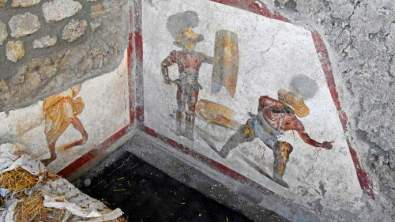In 79 AD, Mount Vesuvius erupted, burying nearby Pompeii — a thriving Roman village during the height of the Roman Empire — killing the inhabitants, and covering the town in a thick and deep coating of volcanic ash.
 Hidden under its ashy cloak, Pompeii lay undisturbed, and forgotten, for hundreds of years. The blanket of ash had the effect of preserving the town as it existed on the date of the eruption. Excavation of the site at Pompeii didn’t begin until the mid-1700s, and continued haphazardly until the mid-1800s, when systemic, organized preservation efforts began and Pompeii became known as a unique opportunity to get a glimpse of what everyday life was like during the heyday of Rome.
Hidden under its ashy cloak, Pompeii lay undisturbed, and forgotten, for hundreds of years. The blanket of ash had the effect of preserving the town as it existed on the date of the eruption. Excavation of the site at Pompeii didn’t begin until the mid-1700s, and continued haphazardly until the mid-1800s, when systemic, organized preservation efforts began and Pompeii became known as a unique opportunity to get a glimpse of what everyday life was like during the heyday of Rome.
Interestingly, Pompeii is still disclosing her secrets. A huge, hundred million dollar preservation, restoration, and excavation project is underway at the site, which is aimed at repairing the parts of Pompeii that were crumbling and making new discoveries. And new discoveries have been made, including uncovering an inscription that helps archaeologists better date the eruption of the volcano, a tavern with a vivid fresco of a bloody but victorious gladiator, and other colorful paintings and decorations. And there are still areas that remain unexplored where the preservationists hope that excavations will yield additional surprises.
We visited Pompeii on our trip to Italy years ago. It was a hot day, we stupidly did not bring bottled water with us for the visit, and the combination of broiling temperatures and the volcanic dust that still is found at the site made that day the thirstiest day I think I’ve ever experienced. Still, it was fascinating to get that peek at life in the distant past. With new discoveries being made, it may be time to make another visit to the town that time forgot.
